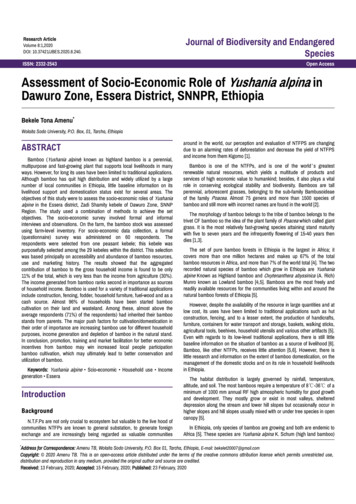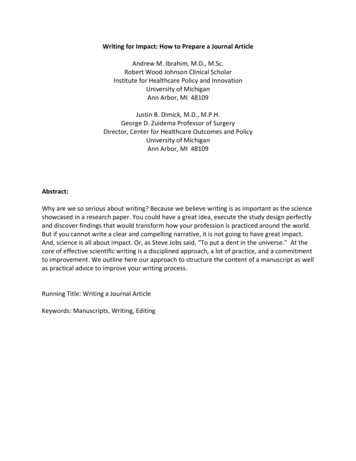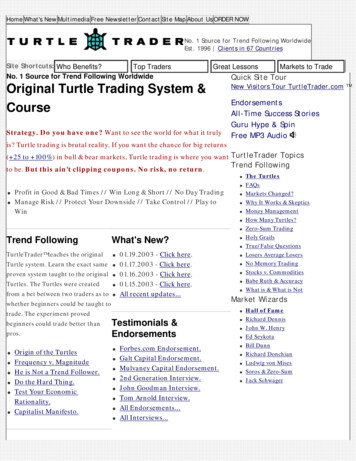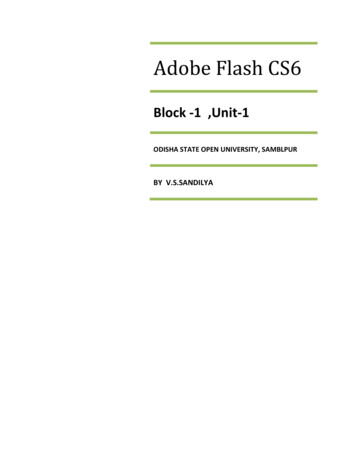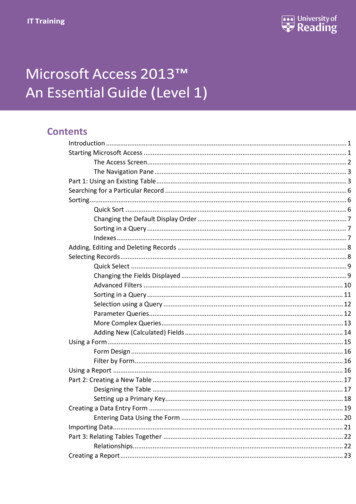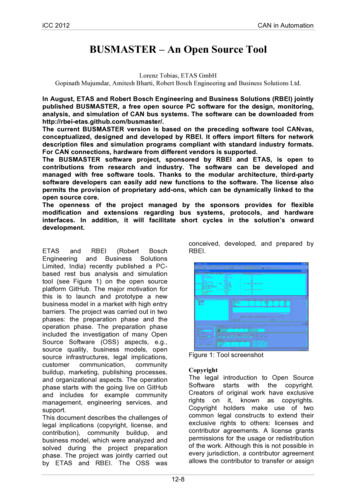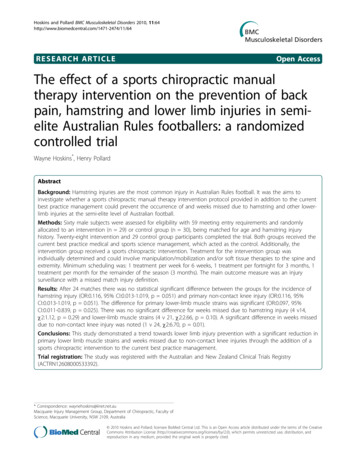
Transcription
Hoskins and Pollard BMC Musculoskeletal Disorders 2010, ESEARCH ARTICLEOpen AccessThe effect of a sports chiropractic manualtherapy intervention on the prevention of backpain, hamstring and lower limb injuries in semielite Australian Rules footballers: a randomizedcontrolled trialWayne Hoskins*, Henry PollardAbstractBackground: Hamstring injuries are the most common injury in Australian Rules football. It was the aims toinvestigate whether a sports chiropractic manual therapy intervention protocol provided in addition to the currentbest practice management could prevent the occurrence of and weeks missed due to hamstring and other lowerlimb injuries at the semi-elite level of Australian football.Methods: Sixty male subjects were assessed for eligibility with 59 meeting entry requirements and randomlyallocated to an intervention (n 29) or control group (n 30), being matched for age and hamstring injuryhistory. Twenty-eight intervention and 29 control group participants completed the trial. Both groups received thecurrent best practice medical and sports science management, which acted as the control. Additionally, theintervention group received a sports chiropractic intervention. Treatment for the intervention group wasindividually determined and could involve manipulation/mobilization and/or soft tissue therapies to the spine andextremity. Minimum scheduling was: 1 treatment per week for 6 weeks, 1 treatment per fortnight for 3 months, 1treatment per month for the remainder of the season (3 months). The main outcome measure was an injurysurveillance with a missed match injury definition.Results: After 24 matches there was no statistical significant difference between the groups for the incidence ofhamstring injury (OR:0.116, 95% CI:0.013-1.019, p 0.051) and primary non-contact knee injury (OR:0.116, 95%CI:0.013-1.019, p 0.051). The difference for primary lower-limb muscle strains was significant (OR:0.097, 95%CI:0.011-0.839, p 0.025). There was no significant difference for weeks missed due to hamstring injury (4 v14,c2:1.12, p 0.29) and lower-limb muscle strains (4 v 21, c2:2.66, p 0.10). A significant difference in weeks misseddue to non-contact knee injury was noted (1 v 24, c2:6.70, p 0.01).Conclusions: This study demonstrated a trend towards lower limb injury prevention with a significant reduction inprimary lower limb muscle strains and weeks missed due to non-contact knee injuries through the addition of asports chiropractic intervention to the current best practice management.Trial registration: The study was registered with the Australian and New Zealand Clinical Trials Registry(ACTRN12608000533392).* Correspondence: waynehoskins@iinet.net.auMacquarie Injury Management Group, Department of Chiropractic, Faculty ofScience, Macquarie University, NSW 2109, Australia 2010 Hoskins and Pollard; licensee BioMed Central Ltd. This is an Open Access article distributed under the terms of the CreativeCommons Attribution License (http://creativecommons.org/licenses/by/2.0), which permits unrestricted use, distribution, andreproduction in any medium, provided the original work is properly cited.
Hoskins and Pollard BMC Musculoskeletal Disorders 2010, ackgroundAustralian Rules football is a unique body contact sport.It is played on a natural grass, oval shaped field, withthe size varying between 135 - 185 meters in length and110 - 155 meters in width. Teams consist of 18 playersper side plus four on an unlimited interchange bench.Each game is played over four 20 minute quarters plusstoppage time. Physical requirements of players include:repeated rapid acceleration and deceleration effortsoften involving change of direction, agility, jumping,bending to pick up the oval shaped ball, tackling andother collisions [1]. There is a continuous nature of playrequiring high aerobic capacity, although the speed ofthe game has increased and now involves a greaternumber of shorter high intensity play periods and longerstop periods [2]. The most important means of ball progression is by punt kicking. Australian Rules football hasthe highest rates of non-contact soft tissue injurieswhen compared with other body contact football codessuch as rugby league and rugby union [3], with the incidence of lower limb muscle strains at the elite nationalcompetition, the Australian Football League (AFL),being 35% per season [4].Hamstring injuries are the most prevalent injury inAustralian Rules football at the AFL [4] and feature prominently at other levels of play [5]. Per season in theAFL hamstring injuries afflict 16% of players, cause 3.4missed matches per injury, account for the most timemissed due to injury and have the highest rates of injuryrecurrence, with one in three injuries recurring onreturn to play [4]. On return to play, player performanceis significantly lower [6]. Hamstring injuries are also themost common muscle injury in running based sports[7]. Knowledge surrounding optimal preventative measures is therefore critical.The prevention of hamstring injuries has long beenrecognized as a priority effort. By contrast, Bahr andHolme [8] have opined that well designed prospectivehamstring injury prevention studies are lacking. Recentliterature reviews have been universal in their depictionof the lack of evidence for the prevention of hamstringinjuries and the requisite for evidence based approachesto be determined through randomized controlled trials(RCTs) [7,9,10]. Prevention of injury becomes more crucial as the most established predictors for hamstringinjury in Australian Rules football are immutable in nature, namely a current or recent history of a hamstringinjury and age [11].Conventional injury prevention has focused on localhamstring factors. Orchard [11] has said that sportsmedicine dogma advises that poor flexibility, fatigue,lack of warm up and weakness are risk factors for injury.The evidence to support this tenet for hamstring injuryPage 2 of 11is lacking [7]. However, a growing body of literature, largely of an indirect nature, suggests that several non-localhamstring factors may have an association with injury[12-16], whilst a Cochrane systematic review of the literature has stated that consideration should be given tothe lumbar spine, sacroiliac and pelvic alignment andpostural control mechanisms when managing hamstringinjuries [17]. Despite the knowledge that non-local factors may exist, the literature appears almost devoid ofresearch investigating their possible identification anddocumenting the effects, if any, of addressing non-localfactors in hamstring injury management [12,16,18].A recent review of the literature stated that newerapproaches that incorporate manipulation in multimodal management approaches for hamstring injuryprevention should be further investigated [9]. Thus itwas the objective of this RCT to investigate whether asports chiropractic intervention consisting of pragmatically and individually determined high-velocity lowamplitude (HVLA) manipulation, mobilization and/orsupporting soft tissue therapies to the spine, pelvis andextremity could reduce local and non-local hamstringinjury risk factors to prevent the occurrence of hamstring and other non-contact lower limb injuries anddecrease low back pain (LBP) and alter health outcomesin semi-elite Australian Rules footballers.MethodsProtocolFour of the thirteen clubs competing in the semi-elitestate based Victorian Football League (VFL) wereapproached and agreed to provide players for this studyduring the 2005 season. However, a change in club staffresulted in two clubs withdrawing support prior to subject recruitment. VFL players train and play in the samecompetition as elite AFL players not selected for firstgrade competition and receive financial remunerationwithout being full time in their playing and trainingcommitments. Players were eligible to participate if theywere listed players on their respective VFL squad andexcluded on the basis of: “red flag” conditions including:fractures, infections, inflammatory diseases, tumours andother causes of destructive lesions of the spine; “yellowflag” conditions including: insurance claims, litigation;history of malignant disease; clinical signs suggestinginguinal or femoral hernia; vascular disease; history ofmotor vehicle accident, or other serious fall or accidentin the last three months; neurological signs and symptoms (muscle wasting, nerve root signs, bowel, bladderor sexual dysfunction); organic kidney, urinary tract orreproductive disease; previous recent spinal surgery (lessthan 2 years); club doctor or medical staff excludes theplayers participation; severe history of chronic hamstring
Hoskins and Pollard BMC Musculoskeletal Disorders 2010, roblems; serious injury or surgery preventing play forthe remainder of the season. Before the start of thestudy the subjects, coaches and medical personal wereinformed about the purpose and design of the study.Club staff gave permission to participate in the study.AssignmentPlayers completed a self-reported questionnaire at theirtraining location prior to randomization. The questionnaire consisted of the validated and reliable McGill PainQuestionnaire (short form) (MPQ-SF) for LBP, the 39item Health Status Questionnaire (SF-39) as well as selfreported questions on knee and hamstring injury history(incidence during the previous month, 6 months, year, 2years, greater than 2 years or not at all). At each of thetwo clubs after completion of the baseline questionnaire,players were randomly allocated into one of two groupssuch that allocation was concealed. Eligible players werestratified by age and hamstring injury history and allocated using a computer generated randomization list foreach club within these strata, as these are the mostrecognized predictors for injury [11]. Randomizationwas completed within each club to prevent an elementof randomness in a clubs injury profile each seasonimpacting on the results of the study. After all subjectshad been allocated the two groups at each club werethen randomly allocated to either the intervention orcontrol with a coin toss.InterventionAll of the players in both the intervention and controlgroup continued to receive what is considered the current best practice medical, paramedical and sportsscience management including medication, manipulativephysiotherapy, massage, strength and conditioning andrehabilitation as directed by club staff, which acted asthe control. All treatment from club staff was independently administered without restriction or interferencefrom the study authors. All staff were employed by theclub and had no limitation in the number or type oftreatment they could render. In addition to this, theintervention group received a sports chiropracticapproach administered by a single practitioner. Treatment was pragmatically and individually determined bythe therapist and could involve HVLA manipulation(either manual or mechanically assisted techniques),mobilization and/or supporting soft tissue therapies: various stretching and soft tissue massage techniques to thespine, pelvis and extremity. According to Mierau et al.[19] manual manipulation involves a brief, shallow,sudden carefully administered thrust (high velocity innature). Mechanically assisted manipulation isperformed through the assistance of devices (for example drop pieces) or impulse type instruments, beingPage 3 of 11non-cavitational and high velocity in intent. Mobilization occurs when a joint is passively moved within itsnormal range of motion (usually a slow oscillatorymovement). Treatment scheduling was also pragmatically determined. The minimum scheduling adhered towas: 1 treatment per week for 6 weeks (phase 1)followed by 1 treatment per fortnight for 3 months and1 treatment per month for the remainder of the season(3 months) (phase 2).Outcome MeasuresThe study was divided into two phases. Phase 1(6 weeks) involved the late pre-season period where preseason matches and the intervention commenced but noinjury surveillance was conducted. Phase 2 (24 weeks)occurred where regular season (home and away) andfinals matches were conducted weekly and an injury surveillance was conducted. The injury surveillance commenced after a period of more intense treatmentscheduling such that the treatment effects, if any, wouldbe observed in a changed injury pattern. At the midpoint of the season (12 home and away season matches,18 weeks of intervention) players completed the MPQSF and the SF-39 as secondary outcome measures attheir training location.The injury definition and injury surveillance conducted was a reproduction of the AFL’s injury surveillance and used as a primary outcome measure for theprevention of hamstring injuries, lower limb musclestrains and non-contact knee injuries [4]. The definitionof an injury was: “any physical or medical condition thatprevents a player from participating in a regular season(home and away) or finals match”. The missed matchinjury definition is currently considered the most reliable injury surveillance method in team sports [20]. Thenumber of games missed due to injury was also determined. Injury diagnoses were determined by club medical staff who were blinded to group allocation usingeither clinical features of injury, advanced imaging orboth at their discretion with blinded club recorderscompleting the injury surveillance. Clinical parametersof injury were also recorded including mechanism ofinjury (contact or non-contact). In this way separationof injuries could be made retrospectively and allocatedinto groups for statistical analysis. To attain this, theplayer was interviewed at the first available opportunityfollowing injury. The club medical and coaching staffindependently determined selection in matches. Therewas no interference from the study authors.In addition a secondary injury surveillance for adverseoutcomes resulting from the intervention was established for the duration of the study with an injury definition of: “any undue pain, discomfort or disabilityarising during, immediately after or subsequent to
Hoskins and Pollard BMC Musculoskeletal Disorders 2010, hiropractic therapy that resulted in missed participationin a match or training session, required additional medical consultation or treatment or was acknowledged by aplayer as not reasonably being associated or expectedwith the normal course of treatment”. If an injuryoccurred, further details on the type of injury, timing ofsymptom onset, duration of symptoms and severity wereto be determined.Statistical AnalysisAll data collected were manually entered using Microsoft Excel and analyzed using SPSS for Windows (version 12.0) or for weeks missed due to injury, SASversion 9.1.3 and PROC GENMOD. Pearson’s “exact”Chi-squared test based on Monte Carlo simulation wasused to assess the efficacy of the intervention withrespect to the number of injuries. Odds ratios and 95%confidence intervals were also included. As such thiscalculation is just an approximation and is included as itis believed that confidence intervals should always bestated [21]. Negative binomial models were used to calculate significance for weeks missed due to injury. Twoindependent sample t-tests were used to compare groupage, hamstring and knee injury history, MPQ-SF andSF-39 at baseline, or if distributions were mixed, Fisher’sexact test was used. Repeated measures and regressionmodels were used to determine change for the MPQ-SFand SF-39. If data were extremely skewed in distribution, transformation of scores was required. Betweengroup differences were obtained from two independentsample t-tests. For global statistical tests, a p value 0.05 was considered significant.Page 4 of 11trol group (n 30) with no baseline differences for age(mean/SD/range intervention 20.2/1.8/18-27, control20.2/1.8/18-25), self-reported hamstring and knee injuryhistory, MPQ-SF and SF-39 (all p 0.05).Injury SurveillanceTable 1 presents the results for the difference in injuryincidence between the groups at the completion of theseason (24 matches, 30 weeks of intervention). Therewas no statistical difference in the prevention ofhamstring injuries (p 0.051) or weeks missed due tohamstring injury (c2 1.12, p 0.29). For primary hamstring injuries, the incidence was 3.6% for the intervention group and 17.2% for the control group, with therecurrence rate being 40.0%. The intervention groupmissed 4 matches due to hamstring injury and the control 14 matches. The intervention group was at a statistically significant reduced risk of suffering a primarylower limb muscle strain injury (p 0.025), equating to3.6% of the intervention group and 27.6% of the controlgroup. The intervention group missed 4 matches with alower limb muscle strain and the control group 21matches (c2 2.66, p 0.10). The difference in primarynon-contact knee injury incidence was not statisticallysignificant (p 0.051), with the incidence being 3.6% forthe intervention group and 24.1% for the control group.The intervention group missed 1 match with a primarynon-contact knee injury and the control group 24matches, the difference being statistically significant(c2 6.70, p 0.01). No players reported an adverse reaction to the intervention.Low Back PainBased on historical AFL data [4] the assumed hamstringincidence level for the null hypothesis is 15%. For a 5%significance level and 80% power, a total sample size of117 is required to detect a 50% reduction in the incidence of hamstring injuries.Table 2 presents the results for the change in baselineMPQ-SF at the mid point of the season. A positive andstatistical significant change for the intervention groupwas achieved for overall (p 0.006) and current LBP (p 0.026). No significant change was noted for the othercomponents of the MPQ-SF (p 0.05).Ethical considerationsHealth StatusAll players gave their written informed consent to participate and ethical approval was obtained from the Macquarie University Human Ethics Committee (EthicsApproval Number: HE27AUG2004-RO3066).Table 3 presents the results for the change in baselineSF-39 at the mid point of the season. A positive statistical change for the intervention group was achieved forrole limitations due to physical health (p 0.004), bodilypain (p 0.034), general health (p 0.027), and physicalsummary score (p 0.013). No other statistically significant change was noted for other health status components (p 0.05).Statistical power calculationResultsParticipantsSixty male Australian Rules football players wererecruited as subjects. Figure 1 shows a flow chartdescribing progress of subjects through the trial for theprimary and secondary outcome measures. Players wererandomly allocated to the intervention (n 29) or con-InterventionTable 4 provides a description of the treatment renderedto the intervention group for the course of the study.
Hoskins and Pollard BMC Musculoskeletal Disorders 2010, igure 1 CONSORT flow chart indicating progress of subjects through the trial.Page 5 of 11
Hoskins and Pollard BMC Musculoskeletal Disorders 2010, age 6 of 11Table 1 Difference between the intervention and control group for injury incidence at the completion of the season(24 matches, 30 weeks of intervention)InjuryIntervention incidence(n 28)Control incidence(n 29)P valueOdds ratio95% CIHamstring injury170.0510.1160.013-1.0191 Hamstring150.1910.1780.019-1.6312 Hamstring02---1 Lower limb muscle strain180.025*0.0970.011-0.8391 Non-contact knee170.0510.1160.013-1.019* Bold type face indicates significant differenceTable 2 Lower Back Pain (as measured by the MPQ-SF): estimated marginal means for baseline and eighteen weeks bygroup and estimated change within and between groupsVariableCurrentOverallBaselineΔ within groups18 weeksΔ between 1.811.64-13.46.02695% CI24.00, 42.5223.62, 41.8112.77, 30.1225.84, 42.88-22.90, -0.73-8.8, 12.14-28.35, 1.44mean26.6722.8617.0427.86-9.635.00-14.63.00695% CI20.54, 32.8016.84, 28.8810.67, 23.4121.60, 34.11-16.35, -2.91-3.07, 13.07-24.93, 4-2.49.46195% CI8.56, 16.5911.32, 19.208.02, 18.0313.29, 23.11-3.67, 4.57-2.54, 8.43-9.24, 4.25Affectivemean4.954.768.3310.723.385.96-2.5895% CI1.78, 8.121.65, 7.873.96, 12.706.43, 15.01-0.73, 7.481.07, 10.85-8.84, 3.6Totalmean10.5312.5611.8116.191.283.63-2.3595% CI7.0, 14.069.10, 16.027.24, 16.3811.70, 20.67-2.57, 5.12-1.14, 8.40-8.36, 3.66.411.436* Bold type face indicates significant difference between groups at 18 weeks.1 Regression analysis showed a significant difference between groups: p-value calculated using regression analysis.DiscussionThis RCT demonstrated that a sports chiropractic manual therapy intervention provided at the semi-elite levelof Australian Rules football in addition to the currentbest practice multi-disciplinary medical, paramedicaland sports science management resulted in the prevention of primary lower limb muscle strain injuries,although no statistical significance was noted for hamstring injury and primary non-contact knee injury. Theaddition of the intervention was associated with areduced number of matches missed due primary noncontact knee injury, although no statistical significancewas noted for hamstring injury and primary lower limbmuscle strains. In addition, reduction in LBP wasobserved along with improvements in some aspects ofthe physical components of health status as measuredby the SF-39. Treatment was predominantly directed atnon-local to hamstring areas, which supports the viewthat several non-local factors may potentially contributeto hamstring and lower limb injury occurrence [7,9],which may be addressed through multimodal and multidisciplinary management [16]. These findings are important due to their potential for injury reduction,performance benefit and cost saving practices for a relatively low cost intervention.There are limitations in the presented study. Becausethe required subject numbers as determined by thepower analysis was not achieved, care is needed in theinterpretation of the results. The late withdrawal of twoclubs reduced the subject numbers recruited and meantthat the required target of subject numbers would notbe reached. Due to the late withdrawal it was decided tocontinue with the study. However, the number of subjects determined by the power analysis is based on anarbitrary determined effect size, and the numbersrequired would have been different if another effect sizehad been chosen. Moreover, the results that are presented report statistical significance and it is difficult todetermine what difference in the raw figures would beclinically significant. As the level of significance for prevention of hamstring injuries and primary non-contactknee injuries was p 0.051, given that the study wasshort of the number of subjects required by the poweranalysis, there is a strong likelihood of a type 2 error,especially considering how close each of these resultswere to p 0.05. With regards to the fact that lowerlimb muscle strain injury incidence was significantlylower while the missed weeks was not, this implies thatmany minor grade strain injuries may have been prevented, but the one injury causing 4 missed matches
Hoskins and Pollard BMC Musculoskeletal Disorders 2010, age 7 of 11Table 3 Health status (as measure by the SF-39): estimated marginal means for baseline and eighteen weeks by groupand estimated change within and between groupsVariablePhysical functioningRole limitation-physicalBodily painGeneral healthVitalitySocial functioningRole limitation-emotionalMental healthPhysical summary scoreMental summary scoreDepressionBaselineΔ within groups18 weeksΔ between entioncontrolmeanp-value% at 8.20, 82.8042.47, 77.5336.86, 74.3415.52, 51.08-5.72, 0.90-11.59, 3.07-6.08, 9.79% at 3, 88.6765.69, 94.3171.81, 98.5922.17, 59.23-2.43, 20.94-31.84, -5.2010.48, .68, 75.6666.57, 78.5567.43, 81.0158.47, 72.05-4.09, 13.21-14.36, -0.240.95, 51, 86.0874.22, 83.7878.51, 89.4269.06, 79.97-2.53, 7.86-10.27, 1.31-0.45, 90, 66.8454.64, 67.5961.67, 72.4054.08, 64.81-0.57, 13.90-9.15, 5.81-1.83, 18.49% at 10051.7053.3058.1044.400.462-5.0925.56295%CI33.51, 69.8935.45, 71.1539.49, 76.7125.66, 63.14-4.76, 5.68-11.56, 1.38-2.56, 13.67% at , 91.4769.95, 96.6582.73, 102.4748.92, 84.48-0.75, 18.03-16.54, 4.201.16, .50, 82.7672.80, 83.0671.61, 81.5766.13, 76.09-6.60, 4.52-12.78, -0.85-2.18, 63, 54.6850.00, 54.0651.76, 55.8547.01, 51.10-1.14, 3.43-5.36, -0.580.89, 1, 52.8747.72, 53.3849.00, 53.8346.06, 50.89-1.38, 4.12-5.34, 1.19-0.72, 7.61% at , 76.5357.47, 89.1371.81, 98.5940.77, 77.831.87, 17.90-12.15, 4.742.23, 24.96.004.034.027.050.770.142.151.013.103.050* Bold type face indicates significant difference between groups at 18 weeks.Table 4 Description of the treatment rendered to the intervention groupIntervention group (n 29)Number of treatments487 (mean per player 17)Amount of manipulation and/or mobilization to jointregions2000 (47% total treatment, mean 4 per treatment)Location of manipulation and/or mobilizationThoracic spine 21%, knee 18%, hip 18%, lumbar spine 15%, sacroiliac joint 12%Manipulation and mobilization breakdownHVLA manipulation only 56%, HVLA manipulation and mobilization 36%, Mobilizationonly 8%Amount of soft tissue techniques to soft tissue regions2258 (53% total treatment, mean 4 per treatment)Location of soft tissue techniquesGluteal region 22%, lumbar spine 12%, hip flexors 10%, knee 9%, posterior thigh 6%* Soft tissue structures are defined as surrounding the involved joint (muscle, tendon, ligament, fascia etc.)skewed the results and meant the comparison would notbe statistically significant. This is important in a smallsample study such as the prevention of one seriousinjury (or not) can significantly alter the weeks lost profile of a particular treatment approach. Only studieswith much larger sample sizes can really effectively confirm this important research observation.Furthermore, a question could be raised regardingcontrol group selection. It was felt that using the clubbased best practice medical, paramedical and sportsscience management as the control was valid becauseno change in hamstring injury rates using this sameapproach have been documented in the AFL’s long running injury surveillance [4]. Corroborating this viewpoint, the hamstring injury incidence reported for thecontrol group (17%) was very similar to that reported inAFL players (16%) using the same methodology.Difficulty arises in attempting to perform research onhigh-level professional or semi-professional athletes dueto clubs not being overly enthusiastic for researchers toperform interventions on their contracted and paidplayers, particularly if the intervention to be performed
Hoskins and Pollard BMC Musculoskeletal Disorders 2010, s purely for control purposes. To counter this dilemmaa pragmatic approach to research design was takenwhich created a further limitation in that subjects werenot blinded to group allocation, meaning it cannot beruled out that the intervention effect was due purely toplacebo or Hawthorne effects, particularly as there wasno blinding of the therapist. However, more modernresearch design often requires new interventions to becompared with the existing best practice approach [22],which was done in this study.The injury surveillance for adverse reactions to treatment may be limited due to the subjectivity of aspectsof the injury definition. Players may not have selfreported injury. If injury was delayed or transient,players may not have attributed injury to the intervention, instead attributing it to training/competition activities or other medical, paramedical or sports sciencemanagement. Such a problem exists in any multi-modalmanagement scenario. Conversely, given the reliabilityof the missed match injury definition [20], it is highlyunlikely that a more severe injury resulting in loss ofcompetition match play was missed.The diagnosis of hamstring strains is usually made onclinical grounds [23]. Hamstring strains are commonlydiagnosed through history (acute onset, non-contactmechanism) and examination (local tenderness, reproducible pain on straight leg raise testing and/or resistedknee flexion) [24]. In professional sport, MRI assessmentis often used to support the clinical diagnosis and providefurther assessment of the extent and severity of theinjury. However, costs and availability preclude the use ofthis modality for routine assessment outside of professional sport. Additionally, both clinical examination andMRI findings are strongly correlated with the timerequired to return to competition, suggesting MRI is notrequired for estimating the duration of rehabilitation ofan acute minor or moderate hamstring injury [25]. MRIimaging to confirm diagnosis of hamstring strains wasnot routinely performed in this study. There are limitations in relying on both clinical methods of d
(either manual or mechanically assisted techniques), mobilization and/or supporting soft tissue therapies: var-ious stretching and soft tissue massage techniques to the spine, pelvis and extremity. According to Mierau et al. [19] manual manipulation involves a brief, shallow, sudden



